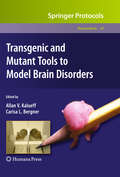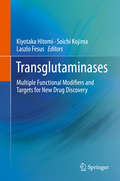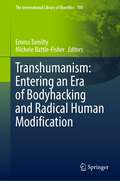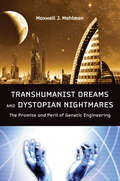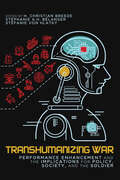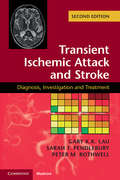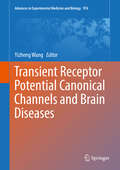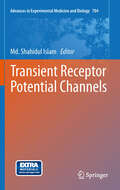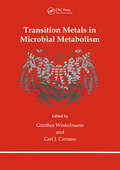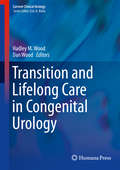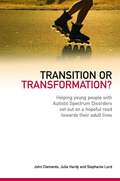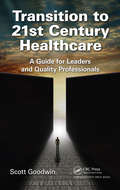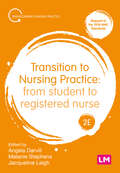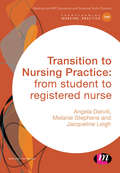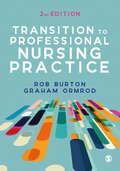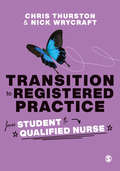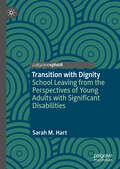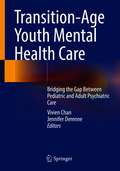- Table View
- List View
Transgenic Xenopus
by Shlomo Seidman Hermona SoreqTwo distinguished international experts offer a fully illustrated, thoroughly referenced guide to the use of microinjected Xenopus embryos to study the role and spatiotemporal regulation of nervous system proteins during vertebrate development. Drs. Seidman and Soreq include all the basic scientific background and protocols needed to consider and exploit the vast potential of this model system. They provide an outline of Xenopus development, detailed methods for in vitro fertilization and microinjection, and protocols and references for a variety of biochemical and histochemical techniques to analyze the results of a microinjection experiment. They also present extensive experimental data illustrating the use of enzyme activity assays, gel electrophoresis, density ultracentrifugation, EAIA, RT-PCR, cytochemical and immunocytochemical staining, and electron microscopy. Transgenic Xenopus demonstrates convincingly the special utility of Xenopus embryo microinjection as a sophisticated and versatile tool for studying nervous system proteins.
Transgenic and Mutant Tools to Model Brain Disorders
by Allan V. Kalueff Carisa L. BergnerAs the presence of genetically modified animal models in research laboratories has multiplied, the role of genetic factors in the pathogenesis of brain disorders has become particularly important. The refinement of molecular genetic methods has continued to broaden our understanding of the genetic factors associated with a variety of disorders. In "Transgenic and Mutant Tools to Model Brain Disorders", leading scientists specializing in this field contribute a timely collection of recent advances featuring a vast array of topics in order to contribute to the diverse approaches taken toward the evaluation of genetically modified models in biomedical research. Opening with several chapters covering general aspects of genetically modified animal models, the book then continues with detailed chapters on models of specific human brain disorders, including OCD, Rett Syndrome, anxiety disorders, depression, and schizophrenia. As a volume in the successful NeuromethodsTM series, the chapters provide authoritative reviews covering the most commonly used approaches in the field. Cutting-edge and concise, "Transgenic and Mutant Tools to Model Brain Disorders" offers a comprehensive and descriptive overview on a variety of topics in neuroscience and biological psychiatry.
Transglutaminases
by Kiyotaka Hitomi Soichi Kojima Laszlo FesusThis book presents basic and extensive information on the physiological and pathological significance of the protein-modifying enzymes, transglutaminases, which are involved in multiple biological events by catalyzing a unique and important posttranslational modification reaction, cross-linking of proteins, and interacting with a large number of proteins inside and outside of cells. Although several of their essential physiological roles have been revealed, many unknown and so far not fully understood functions have remained. In humans, there are eight active isozymes having distinct tissue and subcellular distribution patterns with different substrates and physiological roles. Accordingly, aberrant regulation of the enzyme reactions or expression may lead to or has been implicated in various pathologies including neurodegeneration, fibrosis, cancer, inflammation, celiac disease, and hemostasis disorders. To provide those who are new to the field with basic knowledge and recent information on transglutaminase structures and reactions, the mechanism by which transglutaminases modify substrate proteins and their contributions to multiple biological phenomena as well as disease phenotypes, the publication of the present transglutaminase book was planned, to consist of review articles by 17 expert investigators working in this exciting area of research. The book contains detailed information related to several transglutaminases from aspects in chemical and cellular biology, medical sciences, and biotechnology that will also supply starting points for drug discovery. Although many prominent findings have been published in recent years, this type of comprehensive review book has been missing in the scientific literature. This volume will be useful for investigators who either currently work on or will start addressing transglutaminase-related research, and beyond that, for a broad audience in the scientific community.
Transhumanism: Entering an Era of Bodyhacking and Radical Human Modification (The International Library of Bioethics #100)
by Michele Battle-Fisher Emma TumiltyThis book surveys the distinctions that underlie the unbound potential and existential risks of life expansion and radical modifications posed by a transhuman world. Humanness is in flux as human bodies are being hacked and altered in their quest for super wellness, super intelligence and super longevity. Now is the time to discuss how best to think about dealing with bodies that have been hacked to exceed natural physical limits or more technically, species typical functioning. Enter the advent of transhumanism to take uncertainty by the horns. According to transhumanists, death is unnecessary and medical conventions undermine the possibility to radically evolve. To biohackers, there is no need to wait to explore the risks that conventional medicine dares not. This book is of interest to anyone interested in tapping into this growing movement of modifying the human body as it is right now.
Transhumanist Dreams and Dystopian Nightmares: The Promise and Peril of Genetic Engineering (Bioethics)
by Maxwell J. MehlmanWhat will happen when technology allows us to direct our own evolution?Transhumanists advocate for the development and distribution of technologies that will enhance human intellectual, physical, and psychological capacities, even eliminate aging. What if the dystopian futures and transhumanist utopias found in the pages of science journals, Margaret Atwood novels, films like Gattaca, and television shows like Dark Angel are realized? What kind of world would humans have created? Maxwell J. Mehlman considers the promises and perils of using genetic engineering in an effort to direct the future course of human evolution. He addresses scientific and ethical issues without choosing sides in the dispute between transhumanists and their challengers. However, Transhumanist Dreams and Dystopian Nightmares reveals that radical forms of genetic engineering could become a reality much sooner than many people think, and that we need to encourage risk-management efforts. Whether scientists are dubious or optimistic about the prospects for directed evolution, they tend to agree on two things. First, however long it takes to perfect the necessary technology, it is inevitable that humans will attempt to control their evolutionary future, and second, in the process of learning how to direct evolution, we are bound to make mistakes. Our responsibility is to learn how to balance innovation with caution.
Transhumanizing War: Performance Enhancement and the Implications for Policy, Society, and the Soldier (Human Dimensions in Foreign Policy, Military Studies, and Security Studies)
by H. Christian Breede, Stéphanie A.H. Bélanger, and Stéfanie Von HlatkyThe concept of soldier enhancement often invokes images of dystopian futures populated with dehumanized military personnel. These futures serve as warnings in science fiction works, and yet the enhancement of soldiers' combat capability is almost as old as war itself. Today, soldier enhancement is the purpose of military training and the application of innovative technologies, but when does it begin to challenge individuals' very humanity? Bringing together the work of a diverse group of practitioners and academics, Transhumanizing War examines performance enhancement in the military from a wide range of perspectives. The book builds on two key premises: that rapid advances in science and technology are outstripping governments' and military organizations' capacity to adapt, and that this has put pressure on the connection between the military and the public. The contributors to this collection grapple with the implications of continued technological advancement and the possibility that innovative solutions to performance enhancement will risk further alienating the soldier from society. Navigating the fine line between technological promise and ethics, this volume presents a guide to responsible implementation in Canada and abroad. Offering unique insights into a debate on the bleeding edge of public discourse, Transhumanizing War considers the best ways to improve combat effectiveness while still preserving soldiers' humanity.
Transient Ischemic Attack and Stroke: Diagnosis, Investigation and Treatment
by Gary K. Lau Sarah T. Pendlebury Peter M. RothwellThe second edition of Transient Ischemic Attack and Stroke covers the clinical background and management of the full clinical spectrum of cerebrovascular disease, from TIA to vascular dementia, in a compact, but evidence-based format making a comprehensive primer in stroke medicine. Accurate diagnosis and appropriate investigation and management have a major impact on patient outcomes in cerebrovascular disease, such as the effect of urgent antithrombotic treatment on early recurrent stroke after TIA and minor stroke, the effect of interventions such as thrombectomy and hemicraniectomy in major acute stroke, and the effect of stroke units and organised stroke care. Written by a leading team of clinicians and researchers in the field, this book will be essential to neurologists, geriatricians, stroke physicians, allied health workers and all others with an interest in stroke.
Transient Receptor Potential Canonical Channels and Brain Diseases
by Yizheng WangThis book discusses the latest findings on the physiological and pathological functions of transient receptor potential canonical/classical (TRPC) proteins in the brain. In addition to reviewing the functions of TRPCs in brain development and neuron transmission, it mainly covers the potential roles of TRPCs in brain disorders. TRPC proteins belong to the TRP channel superfamily, which has around 30 members. Just like TRP channels, TRPCs are non-selectively permeable to cations, with a selectivity of calcium over sodium that varies among different members. The TRPC subfamily consists of six members, grouped on the basis of the similarities in gene sequence and protein structure in mammalians. What sets TRPCs apart from other subfamilies in TRPs is that their activation, stimulated by a membrane receptor-phospholipid C (PLC) cascade, contributes to the slow and sustained elevation of intracellular free calcium. Calcium ions, one of the most important types of second messengers, mediate a variety of physiological functions in the brain, including progenitor cell proliferation, dendritic formation, synaptic transmission and neuronal survival. All TRPCs except TRPC7 have been found in various regions of the brain, including the cerebrum, cerebellum, forebrain and hippocampus. This book provides students and investigators with comprehensive information on the regulation, function and potential of TRPCs and brain diseases in order to attract more attention to this field.
Transient Receptor Potential Channels
by Md. Shahidul IslamTransient Receptor Potential Channels offers a unique blend of thoughtfully selected topics ranging from the structural biology of this fascinating group of ion channels to their emerging roles in human diseases. This single book covers TRP channels of yeasts, flies, fishes frogs and humans. And from the biophysics of primary thermo-sensory events in cells to the thermosensation at whole organism level, from physiology of pain to the development of pain-killers, from psychiatric illnesses to cancers, from skin cells to sperms, from taste buds to testes, from established facts to heated debates, this book contains something for every TRP enthusiasts, beginner and expert alike. It includes crucial background information, critical analysis of cutting edge research, and ideas and thoughts for numerous testable hypotheses. It also shows directions for future research in this highly dynamic field. It is a book readers will be just as eager to give to others as keep for themselves.
Transition Metals in Microbial Metabolism
by Gunther WinkelmannThe key role played by iron, as well as other transition metals, in microbial metabolism is investigated in this volume. Topics covered include: iron chelation and siderophores; receptor-mediated bacterial iron transport; and the nitogenases.
Transition and Lifelong Care in Congenital Urology
by Dan Wood Hadley M. WoodTransitional Urology is designed to fill a critical gap that exists in the published literature by comprehensively addressing the urological challenges facing adolescents and adults with complex congenital anomalies of the genitourinary system. It provides a valuable resource to pediatricians and pediatric urologists facing urological management issues beyond their expertise in their aging patients as well as technical guidance to adult urologists who may have had little or no experience caring for patients with a congenital condition. This work will service as a field guide to congenitalism, providing a "how to" approach to guide the urologist using real clinical examples for the most common and challenging urological problems encountered. It also provides a framework for the transition process from pediatric to adult-centered care, with a special emphasis on the multidisciplinary nature needed to provide patient-centered care. Specific conditions that require special consideration, including myelomeningocele, exstrophy, posterior urethral valves, and hypospadias are highlighted. Topics considered common in the general urology practice- like infertility and sexual dysfunction are addressed within the context of patients with neurological or anatomical complexity. In addition, this text reviews urological complaints for which basic clinical algorithms are well-established within the context of a congenitally-abnormal bladder. Chapters discuss how and when special testing like video urodynamnics and positional fluoroscopy may be warranted to provide critical diagnostic guidance. The text also review how typical age-related urological phenomena, like elevated PSA, hypogonadism, and BPH, may present in this subset of patients and how treatment of these conditions may be different than the general population.
Transition bei neurologischen Erkrankungen: Medizinische Herausforderungen im Lebenszyklus neuropädiatrischer Patienten
by Peter WeberDas Buch für die Kinder- und Jugendmedizin und die Neurologie dient den Behandelnden dazu, ihre Kenntnisse zu erweitern und sensibilisiert sie für transitionsmedizinische Fragen. Die Autoren stellen die entwicklungspsychologischen, versicherungsmedizinischen, soziologischen und ethischen Grundlagen der Herausforderungen dar, die die Transitionsmedizin aufwirft. Aus Sicht von Experten und Betroffenen werden konkrete Forderungen für den Übergang der Kinder und Jugendlichen in die medizinische Erwachsenenwelt formuliert. Das Buch zeigt Wege auf, wie sich der Lebenszyklus des Patienten mit einer chronisch-neurologischen Erkrankung in seiner Versorgung optimieren lässt.
Transition from Pediatric to Adult Healthcare Services for Adolescents and Young Adults with Long-term Conditions: An International Perspective on Nurses' Roles and Interventions
by Cecily L. Betz Imelda T. CoyneThis book offers essential information on interventions and actions that enable and promote transition experiences for adolescents and young adults. It provides guidance on appropriate strategies that bring together these groups and caregivers in the context of transition preparation, and those which optimize adolescents’ and young adults’ ability to self-manage their healthcare.The health care transition for adolescents and young adults has gained more attention given the improved survival rates, including for those with long-term conditions. It is now estimated that more than 90% of children diagnosed with a long-term condition will survive into adulthood. The significant change in survival requires concomitant services to facilitate adolescents’ and young adults’ successful transition to adult health care, therefore providers need education, knowledge and skills to support healthcare transition services. A recent US national survey demonstrated only 10% of parents/caregivers reported that their children received transition preparation services. This book is targeted at nurses and pediatric and adult health care providers of different disciplines seeking guidance on which interventions are available, how they can be used, advantages and challenges, and how best to promote a seamless transition for all adolescents and young adults with long-term conditions. It provides several examples of transition programmes and initiatives worldwide. There is an increasing focus on how nurses can support transition but little guidance on what is effective and what has been tried. This book will fill a gap by addressing all of these issues outlined above and by providing worked examples from leading nurse researchers and academics worldwide.
Transition or Transformation?
by John Clements Julia Hardy Stephanie LordYoung people with Autism Spectrum Disorders (ASDs) can often find the step into adulthood and independence more difficult than their neurotypical peers, particularly where employment is concerned. The authors show, however, that with the right guidance and a positive attitude in schools, young people with ASDs can be every bit as happy and successful as those who are not on the spectrum. The book describes a programme developed over a number of years by teachers at a school for young people with ASDs, which successfully enabled autistic pupils to achieve their full potential. The authors explain in detail the challenges faced by the young people at the school, and show how, encouraged by a culture of optimism and hopefulness, the programme developed their confidence and skills, with the result that many of them are now in employment. The book also provides an in-depth exploration of a multitude of styles and techniques for building relationships. Concluding with a reflection on leadership and organisational culture, the authors demonstrate that if the approach is adopted by an entire school and not just a handful of teachers, it really can work. This inspiring and innovative book will be a must for educators at every level, psychologists, academics, and anybody else interested in a positive educational approach that will enable young people with ASDs to get the most out of life.
Transition to 21st Century Healthcare: A Guide for Leaders and Quality Professionals
by Scott GoodwinThis book explains why the fundamental structures of 20th century American healthcare have failed to keep up with American industry in terms of quality and cost. It describes how this has led to the introduction of industrial mass production concepts in American healthcare, such as Lean and Six Sigma, and how the resulting industrialization breaks
Transition to Nursing Practice: From Student to Registered Nurse (Transforming Nursing Practice Series)
by Angela Darvill Melanie Stephens Jacqueline LeighThe transition from student to newly registered nurse can be daunting but with the right preparation, you can step into your new role with confidence. This book provides valuable guidance on what to expect, practical strategies for easing the transition and advice for supporting your ongoing personal and professional development. Key features o Each chapter is mapped to the new 2018 NMC standards o A new chapter on contemporary trends in nursing covers digital skills, peer facilitation, integrated working and more o Self-assessment tools and reflective activities help you to examine your competencies and identify goals for your development o A chapter on health and wellbeing illustrates the importance of self-care and recommends strategies to reduce stress and build resilience
Transition to Nursing Practice: From Student to Registered Nurse (Transforming Nursing Practice Series)
by Angela Darvill Melanie Stephens Jacqueline LeighThe transition from student to newly registered nurse can be daunting but with the right preparation, you can step into your new role with confidence. This book provides valuable guidance on what to expect, practical strategies for easing the transition and advice for supporting your ongoing personal and professional development. Key features o Each chapter is mapped to the new 2018 NMC standards o A new chapter on contemporary trends in nursing covers digital skills, peer facilitation, integrated working and more o Self-assessment tools and reflective activities help you to examine your competencies and identify goals for your development o A chapter on health and wellbeing illustrates the importance of self-care and recommends strategies to reduce stress and build resilience
Transition to Nursing Practice: from student to registered nurse (Transforming Nursing Practice Series)
by Angela Darvill Melanie Stephens Jacqueline LeighDo you feel ready to make the leap from nursing student to fully qualified, registered nurse? Would you like to feel more confident about embarking on the next stage of your nursing career? Moving from student to registered nurse is a big transition and it is important for final year students to feel fully prepared for life after study. Covering a range of topics including accountability, professionalism, re-validation and fitness to practice, this text gives you a thorough overview of the responsibilities associated with being a fully qualified nurse. The book starts by helping you to assess your current level of practice and identify any areas requiring additional attention, allowing you to get the most from your final year of training and enter the workplace with confidence.
Transition to Nursing Practice: from student to registered nurse (Transforming Nursing Practice Series)
by Angela Darvill Melanie Stephens Jacqueline LeighDo you feel ready to make the leap from nursing student to fully qualified, registered nurse? Would you like to feel more confident about embarking on the next stage of your nursing career? Moving from student to registered nurse is a big transition and it is important for final year students to feel fully prepared for life after study. Covering a range of topics including accountability, professionalism, re-validation and fitness to practice, this text gives you a thorough overview of the responsibilities associated with being a fully qualified nurse. The book starts by helping you to assess your current level of practice and identify any areas requiring additional attention, allowing you to get the most from your final year of training and enter the workplace with confidence.
Transition to Professional Nursing Practice: Transition To Professional Practice (Prepare For Practice Ser.)
by Rob Burton Graham OrmrodProvides final year nursing students with comprehensive guidance on how to make the leap from student to registered nurse, helping you to master the skills needed to progress from supervised to professional practice. Packed with key information, theory and advice, this book covers essential topics such as leadership and management, decision-making, professional development, assessment, law and ethics. It also provides you with an insightful overview of global nursing, exploring the issues of nurse migration and outlining the specific requirements for registering as a nurse in countries outside of the UK. To further support your learning, the book includes engaging activities that encourage you to use critical reflection, real-life example scenarios to help improve your decision-making, and references to the author’s personal experiences of professional development.
Transition to Professional Nursing Practice: Transition To Professional Practice (Prepare For Practice Ser.)
by Rob Burton Graham OrmrodProvides final year nursing students with comprehensive guidance on how to make the leap from student to registered nurse, helping you to master the skills needed to progress from supervised to professional practice. Packed with key information, theory and advice, this book covers essential topics such as leadership and management, decision-making, professional development, assessment, law and ethics. It also provides you with an insightful overview of global nursing, exploring the issues of nurse migration and outlining the specific requirements for registering as a nurse in countries outside of the UK. To further support your learning, the book includes engaging activities that encourage you to use critical reflection, real-life example scenarios to help improve your decision-making, and references to the author’s personal experiences of professional development.
Transition to Registered Practice: From Student to Qualified Nurse
by Chris Thurston Nick WrycraftAn essential guide for students transitioning from undergraduate to registered nurse. The book covers all topics included on a final year transition module, is suitable for all fields of nursing, and is mapped to the latest NMC standards. In addition to the book&’s coverage of key final year transition topics such as law and ethics, decision making and clinical accountability, there is also helpful guidance on how to further your career and become a successful nurse, post-registration. This includes advice on leadership and management skills, preceptorship, revalidation, and continued professional development (CPD). To help students understand the realities of being a registered nurse, there are &‘Practice Scenarios&’ in each chapter and real-life accounts from service users expressing their experience of using health services, so that students can understand the real needs of people in their care. The book also includes examples and scenarios from all fields, to show the differing practice environments and challenges that students will face.
Transition to Registered Practice: From Student to Qualified Nurse
by Chris Thurston Nick WrycraftAn essential guide for students transitioning from undergraduate to registered nurse. The book covers all topics included on a final year transition module, is suitable for all fields of nursing, and is mapped to the latest NMC standards. In addition to the book&’s coverage of key final year transition topics such as law and ethics, decision making and clinical accountability, there is also helpful guidance on how to further your career and become a successful nurse, post-registration. This includes advice on leadership and management skills, preceptorship, revalidation, and continued professional development (CPD). To help students understand the realities of being a registered nurse, there are &‘Practice Scenarios&’ in each chapter and real-life accounts from service users expressing their experience of using health services, so that students can understand the real needs of people in their care. The book also includes examples and scenarios from all fields, to show the differing practice environments and challenges that students will face.
Transition with Dignity: School Leaving from the Perspectives of Young Adults with Significant Disabilities
by Sarah M. HartThis book analyzes the process of leaving school, commonly referred to as 'transition' for young adults with severe, complex, and multiple disabilities. It seeks to challenge prevailing assumptions and offer practical steps towards reversing customary accepted theories, methods, practices, and outcomes. Despite extensive research, policies, and procedures of transition, the reality is that post-school outcomes are worrying for those with significant special needs. Community inclusion depends as much upon in-school procedures and support systems as it does the inclusivity of society itself. This book directly addresses these concerns by examining the experiences of young adults living through their transitions in two countries, Aotearoa New Zealand and the USA. Engaging and highly readable case narratives bring fresh insights on the diversity of disability experiences, portraying the under-explored opportunities involved in a transition with dignity. Disability is an often overlooked aspect of one’s intersectional identity. Post-school transition is therefore positioned less as a procedural function of leaving school and more so an urgent matter of social justice. Readers will benefit from the transformative framing of post-school transition based on the capability approach. Genuine opportunities within the transition of young adults with significant disabilities and those who support them may promote a thriving life for all.
Transition-Age Youth Mental Health Care: Bridging the Gap Between Pediatric and Adult Psychiatric Care
by Jennifer Derenne Vivien ChanOver the course of the last two decades, improved practices in child and adolescent mental healthcare have led to a decreased environment of stigma, which also led to an increased identification and treatment of mental health disorders in children and youth. Considering that treatment and outcomes are improved with early intervention, this is good news. However, the success gained in the field of child and adolescent psychiatry leads to a new challenge: transitioning from adolescent care to adult care. It has been known for some time that children, adult, and geriatric patients all have unique needs where it comes to mental healthcare, yet limited work has been done where it comes to the shifting of the lifespan. Where it comes to the child-adult transition—defined as those in their late teens and early/mid-20s—there can be multiple barriers in seeking mental healthcare that stem from age-appropriate developmental approaches as well as include systems of care needs. Apart from increasing childhood intervention, the problem is exacerbated by the changing social dynamics: more youths are attending college rather than diving straight into the workforce, but for various reasons these youths can be more dependent on their parents more than previous generations. Technology has improved the daily lives of many, but it has also created a new layer of complications in the mental health world. The quality and amount of access to care between those with a certain level of privilege and those who do not have this privilege is sharp, creating more complicating factors for people in this age range. Such societal change has unfolded so rapidly that training programs have not had an opportunity to catch up, which has created a crisis for care. Efforts to modernize the approach to this unique age group are still young, and so no resource exists for any clinicians at any phase in their career. This book aims to serve as the first concise guide to fill this gap in the literature. The book will be edited by two leading figures in transition age youth, both of whom are at institutions that have been at the forefront of this clinical work and research. This proposed mid-sized guide is therefore intended to be a collaborative effort, written primarily by child and adolescent psychiatrists, and also with adult psychiatrists. The aim is to discuss the developmental presentation of many common mental health diagnoses and topics in chapters, with each chapter containing clinically-relevant “bullet points” and/or salient features that receiving providers, who are generally, adult-trained, should keep in mind when continuing mental health treatment from the child and adolescent system. Chapters will cover a wide range of challenges that are unique to transition-age youths, including their unique developmental needs, anxiety, mood, and personality disorders at the interface of this development, trauma and adjustment disorders, special populations, and a wide range of other topics. Each chapter will begin with a clinical pearl about each topic before delving into the specifics.

